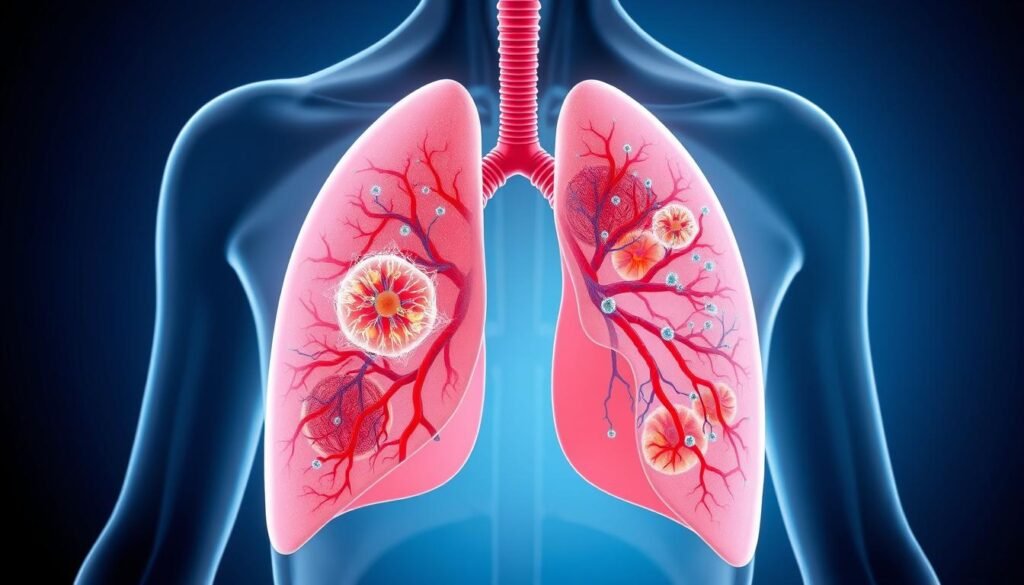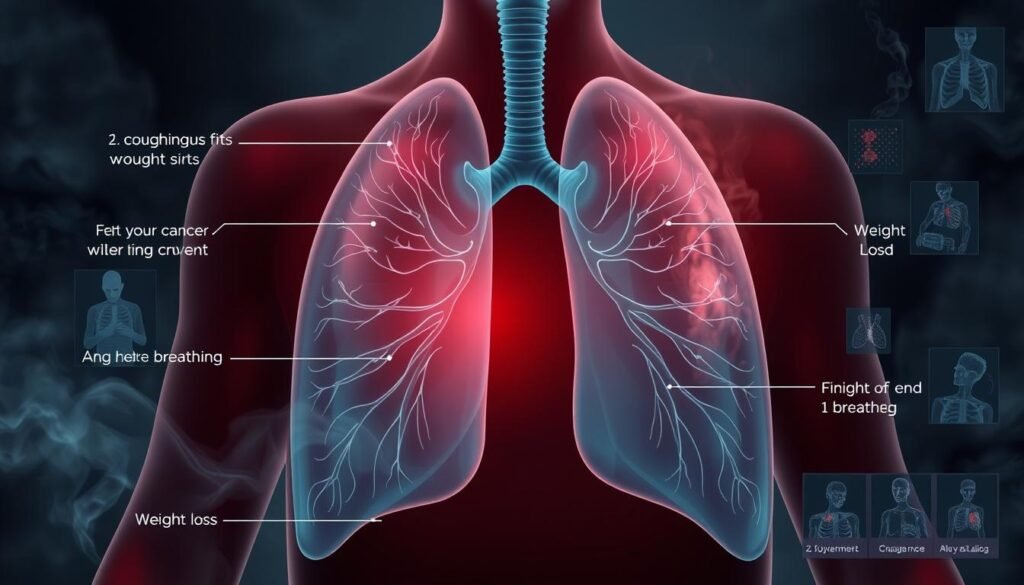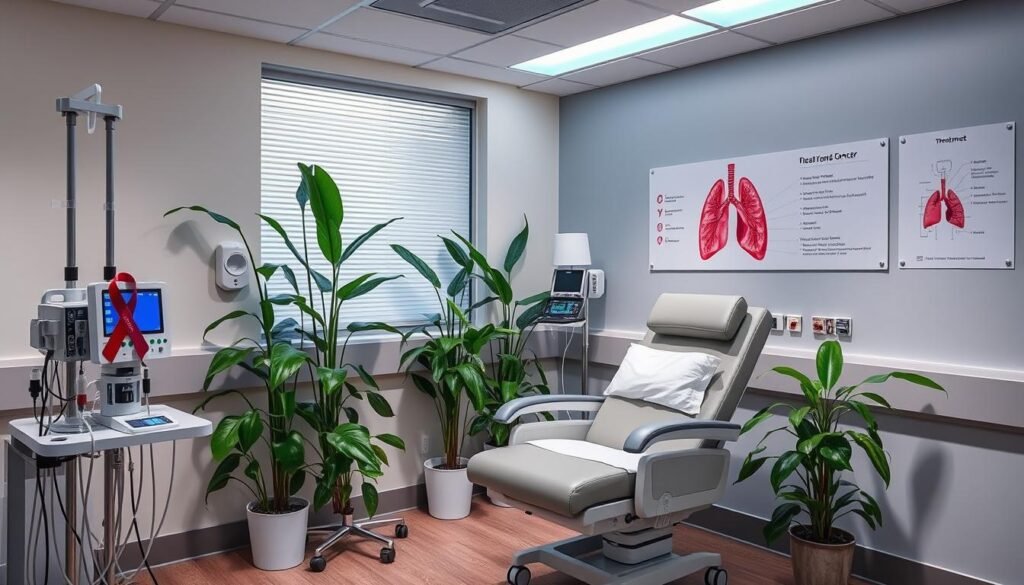Lung cancer causes about 25% of all cancer deaths in the United States. This fact shows how important it is to understand the lung cancer spread. It also shows why knowing the symptoms and treatment options is crucial. Finding lung cancer early is key to improving survival rates.
It’s essential for people to get information from specialized oncologists and trusted cancer centers. Being aware of lung cancer’s details can help patients and their families. They can take active steps to manage their health better.
Key Takeaways
- Lung cancer is the leading cause of cancer deaths worldwide.
- Understanding lung cancer spread aids in early detection and better outcomes.
- Comprehensive treatment options are available, including surgery, chemotherapy, and immunotherapy.
- Smoking and secondhand smoke are major risk factors associated with lung cancer.
- Consulting with top specialists can significantly improve treatment effectiveness.
What is Lung Cancer?
Lung cancer starts when cells in the lungs change in a bad way. This often happens from smoking or being around harmful things. These changed cells grow too much and hurt the good lung parts. Lung cancer is of two kinds. One starts in the lungs, and the other spreads from elsewhere.
Knowing about lung cancer symptoms is very important. Usually, symptoms don’t show up until it’s advanced. This makes it hard to treat early. But early checks and screenings can save lives. They are really important for those over 50 or who smoked a lot. Even people who stopped smoking in the last 15 years should think about getting screened.
To find out if it’s lung cancer, doctors use tests like X-rays and CT scans. They might take a small piece of the lung to check for cancer cells. Each person’s cancer is different. So, it’s key to talk to doctors who know a lot about cancer for the best treatment.
Causes of Lung Cancer
The main causes of lung cancer are tobacco use and exposure to dangerous substances. About 90% of lung cancer cases come from smoking. Even though many smokers try to quit, only a small number succeed.
Besides smoking, other factors like radon exposure also increase lung cancer risk. Radon is a natural radioactive gas found in some homes. Air pollution and being around carcinogens at work, like asbestos, are also to blame.
Smoking is behind one-third of all cancer cases. It’s key to understand how lung cancer and smoking are linked. This helps in making plans to prevent it. Even with quitting aids like patches, getting the right help is tough. Only 30% of people get the medicine or advice they need.
https://www.youtube.com/watch?v=ihCnDjyJv5c
We need more education on the causes of lung cancer. This includes how to stop smoking and the risks of radon. Our goal is to lower risks and make lungs healthier for smokers and everyone else.
Types of Lung Cancer
Lung cancer is mainly split into two types: non-small cell lung cancer (NSCLC) and small cell lung cancer (SCLC). These types make up most lung cancer cases in the U.S. NSCLC is more common, making up about 85% of cases.
NSCLC has a few different kinds:
- Adenocarcinoma: This type is the most usual, found in both smokers and non-smokers. It’s more common in women and young people.
- Squamous cell carcinoma: This one is closely tied to smoking and usually starts in the lungs’ middle parts.
- Large cell carcinoma: It grows quickly and looks a lot like SCLC, being very aggressive.
SCLC makes up about 15% of lung cancer cases. It spreads fast and is very aggressive. Spotting it early is crucial for treatment.
An extra cancer type, mesothelioma, accounts for 5% of lung cancers. It’s rare but aggressive and linked to asbestos exposure, affecting the lungs’ lining.
Knowing these types helps doctors find the best treatment. Each lung cancer type poses different challenges. It’s vital to know the symptoms and get checked early. If you have a lasting cough or lose weight without trying, see a doctor. For more on early symptoms of lung cancer, click this link.
| Type of Lung Cancer | Percentage of Cases | Key Characteristics |
|---|---|---|
| Non-Small Cell Lung Cancer (NSCLC) | 85% | Includes adenocarcinoma, squamous cell carcinoma, and large cell carcinoma. |
| Small Cell Lung Cancer (SCLC) | 15% | Rapid growth and aggressive spread, needing early detection. |
| Mesothelioma | 5% | Often caused by asbestos exposure, affecting the lung lining. |
Understanding Lung Cancer Spread
Knowing how lung cancer spreads helps us understand its treatment better. It mainly spreads by invading nearby areas and through metastasis. First, cancer cells move to neighboring tissues and the lymph system, playing a key role in the disease’s growth.
How Lung Cancer Spreads
About 40% of those diagnosed with lung cancer experience metastasis. It usually moves to lymph nodes in the lungs or near major airways. In advanced cases, 30% to 40% of patients see bone metastases, and up to 40% develop brain metastases. Liver metastasis occurs in 30% to 50% of advanced-stage cases.
Lung cancer cells often spread to the brain, bones, adrenal glands, and liver, especially with small cell lung cancer. This pattern shows why it’s crucial to understand how lung cancer progresses and spreads.
The Role of Lymphatic System
The lymphatic system plays a big part in lung cancer’s advancement. If lung cancer reaches the lymph nodes, it’s more likely to spread to distant organs. Cancer cells travel from the lungs to lymph vessels, aiding in spreading the cancer. By the time it’s diagnosed, about 75% of lung cancers have metastasized. This makes early detection and treatment key to fighting this aggressive disease.

Stages of Lung Cancer
Knowing the stages of lung cancer is key to finding the right treatment. It tells doctors how much the cancer has grown. Understanding these stages helps decide how to treat it best.
Non-Small Cell Lung Cancer Stages
Non-small cell lung cancer, or NSCLC, has stages from 0 to IV. Each stage shows how much the cancer has spread. Here’s a quick look at these stages:
| Stage | Description |
|---|---|
| 0 | Carcinoma in situ, confined to the top lining of the lung or bronchus. |
| I | Subdivided into IA and IB, with no spread to lymph nodes or distant tissues. |
| II | Further divided into IIA and IIB, indicating tumor characteristics without distant organ spread. |
| III | Categorized as IIIA, IIIB, or IIIC, often involving lymph nodes in the mediastinum. |
| IV | The most advanced stage, indicating metastasis to other body areas. |
The T, N, and M system shows tumor size, lymph node involvement, and if it has spread. A higher number means the cancer has grown more. Advanced lung cancer might need tougher treatments.
Symptoms of Lung Cancer
Lung cancer signs are often unnoticed until it’s far advanced. Early detection of signs can lead to better treatment results. Symptoms like a persistent cough, shortness of breath, and chest pain may appear early.
Understanding all symptoms is crucial, especially for those at higher risk. Key symptoms needing medical check include:
- Coughing up blood (hemoptysis)
- Loss of appetite
- Sudden weight loss
- Hoarseness
- Fatigue
- Wheezing
- Weak immune response to infections
As the cancer progresses, symptoms worsen. This may include bone pain and swelling areas like the neck, indicating lymph node issues. Severe symptoms can show as:
- Headaches or constant dizziness
- Limbs feeling weak or numb
- Jaundice
- Lumps in neck or collarbone area
Some people may have unique syndromes tied to lung cancer. For example, Horner syndrome, which includes nerve damage signs, or Superior Vena Cava syndrome, causing upper body swelling. Paraneoplastic syndromes also impact distant organs, making early detection harder.
Those with small cell lung cancer often have symptoms like coughing blood, chest tightness, and breath shortness. Spotting these signs early is key to getting timely help and improving chances of recovery.

| Early Signs of Lung Cancer | Advanced Symptoms |
|---|---|
| Persistent cough | Bone pain |
| Coughing up blood | Swelling in face, arms, or neck |
| Shortness of breath | Headaches and dizziness |
| Chest discomfort | Weakness or numbness in limbs |
| Loss of appetite | Lumps in the neck or collarbone area |
Diagnosis of Lung Cancer
The process of finding lung cancer usually starts with imaging tests. These include chest X-rays or CT scans. They help spot any unusual signs in the lungs. When there’s a chance it’s cancer, more tests are often needed to be sure.
To know for sure if it’s cancer, biopsy methods are key. Doctors might use a tool called bronchoscopy or needles to get lung tissue samples. This helps them see if cancer cells are present and what kind of lung cancer it might be.
Doctors might also use MRI and PET scans for a closer look. MRI scans show detailed images of soft tissues. They check for cancer spread to the brain and heart. PET scans highlight active cancer cells, showing how much the cancer has grown. Using PET/CT scans together gives a clear picture for planning treatment.
Tests like endobronchial ultrasound, mediastinoscopy, and thoracoscopy are next. They’re important for figuring out the cancer’s stage. Knowing the stage helps doctors choose the best treatment. Staging looks at tumor size and growth.
| Imaging Test | Purpose | Duration |
|---|---|---|
| Chest X-ray | Initial assessment for lung abnormalities | 5-10 minutes |
| CT Scan | Detailed imaging of lung structure | 10-30 minutes |
| MRI Scan | Assess soft tissue and organ involvement | 30-60 minutes |
| PET Scan | Evaluate cancer spread in the body | 30-60 minutes |
| Bronchoscopy | Obtain tissue samples from airways | 30-40 minutes |
| Mediastinoscopy | Lymph node sampling for staging | Varies |
Knowing every step of diagnosing is crucial for fighting lung cancer. With the right diagnosis, patients can get treatments best suited for them.
Treatment Options for Lung Cancer
Lung cancer treatments depend on the cancer’s type, stage, and the patient’s health. Often, combining therapies yields the best results. Main treatments include surgery, chemotherapy, targeted therapy, and immunotherapy.
Surgery
For early-stage non-small cell lung cancer (NSCLC), surgery can be key. In stage 0, it might be the only treatment needed. By stage I, surgery may suffice, but additional therapy is an option to lower recurrence risks.

At stages II and III, treatment becomes more aggressive. Patients might get chemotherapy before surgery to reduce the tumor size. In stages IIIA and IIIB, treatment may include chemotherapy, radiation, immunotherapy, and surgery. Combining these increases effectiveness.
Metastatic lung cancer has spread to other body parts. Treatment may include targeted therapy, immunotherapy, chemotherapy, and sometimes radiation. Recent advances have improved survival rates.
To learn more, patients should look at detailed treatment guides. Considering clinical trials offers access to new therapies. A team of experts ensures best outcomes.
The Importance of Early Detection
Finding lung cancer early is key to better treatment results and longer lives. Only 21% of lung cancers are found when still local. This shows the need for screening programs for people at high risk. People who have smoked a lot are encouraged to get checked every year. This is advised by groups like the American College of Chest Physicians. They suggest low-dose CT scans for those 55-77 years old with a heavy smoking past.
The advantages of catching lung cancer early are huge. The National Lung Screening Trial showed annual checks can lower death rates from lung cancer by 20%. It’s vital that people making the decision to screen understand what’s good about it and what the dangers are. This includes false alarms and the risk from x-rays.
Health insurance usually pays for screenings for eligible people. This includes those 50 to 80 years old who smoked a lot in the past. Groups like the National Comprehensive Cancer Network stress how crucial screening is. Catching the disease early increases the chance of successful treatment. For instance, people found with stage IA lung cancer might live much longer. This is a big difference compared to the survival rates for stage IV cancer.
| Age Group | Recommended Screening | Status |
|---|---|---|
| 50-80 years | Annual screening for 20 pack-year history | NCCN, USPSTF |
| 55-77 years | Annual low-dose CT for 30 pack-year history | CHEST |
| 55-77 years | Annual low-dose CT for active smokers | CHEST |
Joining a lung cancer screening program helps people take charge of their lung health. Knowing how important it is to find cancer early leads to treatments that work better. This improves chances for many people.
Conclusion
Understanding lung cancer spread is key to better patient care. Knowing the symptoms, risks, and treatments helps people get timely help. Since over half of lung cancer cases spread before detection, early discovery is vital. This could save more lives and boost survival rates nationwide.
Very few of those who should get screened actually do. This shows we must push for more lung cancer awareness. Getting a yearly low-dose CT scan can greatly lower death rates. It’s critical to promote these screenings, particularly for those at high risk.
With better awareness and action, we can change lung cancer management for the better. This way, more people can get help early and have better support.
Research keeps improving our knowledge and treatment of lung cancer. Pushing for early detection and raising awareness can dramatically alter how we deal with it. By working together and spreading knowledge, we can aim for a future where lung cancer’s impact is much less harsh. This would make life better for many and reduce the disease’s heavy toll.